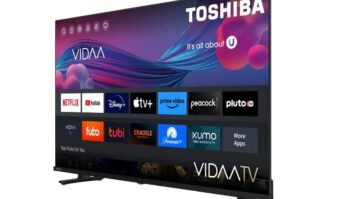Hewlett-Packard has expanded its line of home-theater display products to include four DLP-based rear-projection HDTVs, while adding to its LCD and plasma display line. The company also unveiled three next-generation Digital Media Center PCs, including the company’s first two models to incorporate ATSC tuning during the Home Entertainment Show, here.
Joshua Rush, HP’s digital entertainment marketing manager, said the new products are part of HP’s “Pavilion Suite” of digital entertainment products. All will continue to be distributed through an evolving retail rollout that for the balance of the year will continue to focus on regional A/V specialty dealers, as well as selling through its online direct marketing program.
Rush said HP continues to focus on dealers who can effectively sell the enhanced features and performance quality benefits of HP’s models. The goal is to build the marketing strength of the home theater line to match HP’s reputation in the IT field, Rush said.
A key in that strategy comes from the new Digital Media Center PCs, which have been improved to incorporate HDTV reception capability for the first time.
“We aren’t promoting a hard bundle of our Digital Media Centers with our video-display products, but we are working with our retailers to display the complete HP story together,” said Rush. “This will take place using dedicated HP end-caps, to demo pods to experience setups in the store.”
The two step-up units in the line offer ATSC off-air tuners (as well as dual NTSC tuners), which will allow users to view broadcast DTV stations on connected display monitors, as well as record programs to hard-disk drives. The included DVR software will allow the recording of two NTSC channels and an ATSC channel simultaneously, while a recorded program is played back.
While the Digital Media Centers include IEEE-1394 inputs, they are enabled only for data, digital camera and DV-format camcorder material. A company representative explained that Microsoft’s Media Center operating system does not yet support DTCP video content, meaning that no connection is possible to satellite or cable TV set-top boxes to receive digital video content from multichannel service providers.
Current units of the next-generation Digital Media Centers, which are all shipping now, lack any broadcast-flag recognition, Rush confirmed.
Models include the entry Z552 ($1,499 suggested retail) which features a recordable DVD drive, and dual NTSC tuners. The step-up Z555 ($1,999) offers dual NTSC and one ATSC tuner, and a 250GB hard drive. The top of the line Z557 ($2,599) offers a 3.0 GHz processor, 1GB RAM, 600GB hard drive, dual NTSC tuners and one ATSC tuner.
The company added a total of 10 new television displays, including four DLP-based rear-projection HD displays, three HDTV LCD TVs and three HDTV plasma displays. Some of the new sets were developed to capitalize on HP’s legacy in computer printing technology which “overlaps printing on paper with printing with light,” Rush said.
An example is HP’s use of its Wobulation technology in its new rear-projection DLP line. Wobulation technology effectively doubles the resolution onscreen “so that in the case of a 1,080i signal we are able to produce a 1,080p image,” said the HP representative. HP is working with TI to incorporate its Wobulation technology in the DLP chip set, the company said.
HP’s 1,080p sets also include a seven-segment color wheel producing 9-bits of color and a Dynamic Aperture function which is said to yield a contrast ratio of 8,400:1.
The DLP rear-projection models include one 50W-inch model with native 1,280 by 720p resolution; two 58W-inch models, one with 720p resolution and the other with 1,920 by 1,080p resolution; and a flagship 65W-inch model with 1,080p resolution. All models feature built-in ATSC tuning. Digital CableCARD slots are standard in the 1,080p models, and as an optional step-up on 720p sets. At this time, none of the sets include TV Guide On Screen programming guides.
The DLP sets, which are slated to ship in July, were also developed to optimize ease of use and setup, the company said. All input and output jacks are mounted behind a hinged front-panel door for easy connection to source components when using an optional stand that is designed to run cables up through the front of the set, but behind the front panel plate.
Inputs include two HDMI inputs, two component video inputs, a VGA input, a USB port “for firmware upgrades” and an RS-232 port.
In flat panel, the company announced it will ship this fall three new LCD TV models in the 26W-inch, 32W-inch and 37W-inch screen sizes, all offering 1,366 by 768 HD resolution, and three plasma models including a 42W-inch EDTV, a 42W-inch HDTV and a 50W-inch HDTV model.
All models include built-in ATSC tuning and digital CableCARD slots. A company spokesman said HP is still determining whether or not to add TV Guide On Screen capability.
Plasma models also include SD card slots for digital image viewing.
Inputs include VGA, DVI-HDCP and HD component video. LCD TV models also include IEEE-1394 inputs.
LCD models offer 450 nits of brightness and 800:1 contrast ratios, while the plasma models list 1,200 candelas of brightness and a 3,000:1 contrast ratio.













